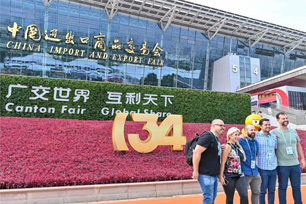Shadow play (ICH)
3. Creation of an Art
Paperand silk were originally used to make silhouettes, but cow, sheep and donkey hide (said to be the best for its transparency and durability) were found to be more suitable.
Processing a hide to the required degree of transparency is, however, a painstakingly elaborate process. It needs to be soaked in water for several days before being cleaned and having the hair, every vestige of fat and flesh scraped off. The resultantly fine, transparent sheet is then stretched over a wooden frame and left to air in the shade. Patterns nailed to the sheet are carved out, painted, ironed and coated in protective tung oil. The trunk, head and limbs of a puppet are carved out separately. Finally, the silhouettes are assembled, sewn at the joints and affixed with pulling strings and sticks so the puppets can simulate human movement. The puppets are painted various colors to show off their various qualities -- kind or wicked, beautiful or ugly.
Silhouette puppets are in themselves works of art. They incorporate folk painting and paper cuts, and through adoption of realistic and abstract approaches embody distinguishable character traits appropriate for shadow performances.
Shadow puppets consist of upper and lower bodies, legs, arms, hands and interchangeable heads. Any shadow play troupe prop box would contain more than 1,000 different heads to fit 200-300 bodies. Heads are either full-face or in profile with exaggerated features in order to achieve a better two-dimensional effect.
4. Main Genres
The shadow play found all over the country, is popular in Hebei, Henan, Shandong, Shanxi, Shaanxi, Gansu, Zhejiang, Liaoning and Beijing, each place distinctive in regards to the materials used to make puppets and their characterization. But the biggest differences are in different music and chanting tunes, styles of performance, and manipulating skills, based on which different genres have been formed.
I Tangshan Shadow Play
Declarer:Tangshan city,Hebei province
The Tangshan shadow play, also known as the Leting or Luanzhou Shadow play, formed at the end of the Ming Dynasty (1368-1644) and developed during the late period of theQing Dynasty(1644-1911) and the early stages ofthe Republic of China. It is one of the biggest genres of Chinese shadow plays and has a history of more than 400 years.
II Southern Hebei Shadow Play
Declarer:HandanCity, Hebei province
The shadow play in southern Hebei originated from the royal shadow plays in Beijing.
III Xiaoyi Shadow Play
Declarer:Xiaoyi city,Shanxi province
Xiaoyi Shadow Play originated in theWarring States Period(475-221BC) in Xiaoyi city, one of the cradles of Chinese shadow play art. It adopts the Pi tune as its aria and the suona horn as its main accompanying instrument.
IV Fuzhou Shadow Play
Declarer:Wafangdian city,Liaoning province
Fuzhou Shadow Play was first introduced to Wafangdian by the frontier garrison dispatched from Shaanxi during the late (1573-1620) Ming Dynasty (1368-1644). It was prevalent in the Qing Dynasty.
V Haining Shadow Play
Declarer:Haining city,Zhejiang province
The shadow play was introduced to Haining in theSouthern Song Dynasty(1127-1279). It formed its unique southern tune by adopting theYiyang Tuneand the Haiyan Tune. The libretto and spoken parts were also changed into the local dialect. The custom of worshipping the silkworm god became the special content of the shadow play in Haining, hence it was also called the Silkworm Opera.
VI Jianghan Plain Shadow Play Declarer:Qianjiang city,Hubei province
The Jianghan Plain is in south-central Hubei province. The shadow play popular here is famous for its puppetcarving artand its singing tunes and Yugu (literally fishing and drumming) tune.
VII Lufeng Shadow Play
Declarer:Shanwei city,Guangdong province
Lufeng shadow play is the only legacy ofChaozhoushadow plays, one of the three shadow play categories in China. It formed in the Song Dynasty and was popular during the Ming and Qing dynasties.



 Print
Print Mail
Mail

